-
 Bitcoin
Bitcoin $107,467.9126
1.26% -
 Ethereum
Ethereum $2,447.5288
-0.12% -
 Tether USDt
Tether USDt $1.0005
0.00% -
 XRP
XRP $2.1921
0.13% -
 BNB
BNB $647.2897
0.50% -
 Solana
Solana $144.8627
-0.37% -
 USDC
USDC $0.9996
-0.03% -
 TRON
TRON $0.2732
0.10% -
 Dogecoin
Dogecoin $0.1652
-0.18% -
 Cardano
Cardano $0.5700
-2.87% -
 Hyperliquid
Hyperliquid $37.0274
-1.81% -
 Bitcoin Cash
Bitcoin Cash $484.6957
0.19% -
 Sui
Sui $2.7354
-2.19% -
 Chainlink
Chainlink $13.1727
-1.49% -
 UNUS SED LEO
UNUS SED LEO $8.9978
-0.04% -
 Stellar
Stellar $0.2421
-2.33% -
 Avalanche
Avalanche $17.5633
-3.51% -
 Toncoin
Toncoin $2.8476
-1.94% -
 Shiba Inu
Shiba Inu $0.0...01166
-0.56% -
 Litecoin
Litecoin $85.1071
0.09% -
 Hedera
Hedera $0.1502
-2.96% -
 Monero
Monero $310.2774
-1.64% -
 Dai
Dai $0.9999
-0.01% -
 Polkadot
Polkadot $3.3584
-1.88% -
 Ethena USDe
Ethena USDe $1.0003
-0.04% -
 Bitget Token
Bitget Token $4.4443
2.90% -
 Pi
Pi $0.6242
14.04% -
 Uniswap
Uniswap $6.9774
-2.86% -
 Pepe
Pepe $0.0...09535
-5.05% -
 Aave
Aave $256.7574
-3.35%
What is the difference between GameFi and traditional games? Characteristics of blockchain games
GameFi empowers players with asset ownership and financial incentives, but faces challenges like crypto volatility and scalability issues.
Jun 04, 2025 at 07:56 pm

GameFi represents a new paradigm in the gaming industry, combining elements of gaming and decentralized finance (DeFi) on blockchain technology. Unlike traditional games, GameFi introduces the concept of earning real-world value through gameplay, often in the form of cryptocurrencies or non-fungible tokens (NFTs). This revolutionary approach not only enhances player engagement but also empowers players with ownership of in-game assets.
Traditional games typically operate within a centralized framework where the game developers control all aspects of the game, including the economy and assets. Players invest time and sometimes money into these games, but the assets they acquire remain the property of the game's developers. In contrast, GameFi leverages blockchain technology to create a decentralized gaming ecosystem. Here, players can truly own, trade, or sell their in-game assets, which are represented as NFTs on the blockchain.
One of the most significant differences between GameFi and traditional games lies in the economic model. Traditional games often rely on microtransactions and in-app purchases to generate revenue, which can lead to pay-to-win scenarios. GameFi, on the other hand, introduces play-to-earn mechanics, where players can earn tokens or NFTs by participating in various in-game activities. These tokens can then be traded on external marketplaces, providing players with a potential source of income.
The integration of blockchain technology in GameFi also ensures transparency and security. Every transaction and asset transfer is recorded on the blockchain, making it immutable and verifiable. This feature eliminates the risk of fraud and manipulation, which can be a concern in traditional gaming environments. Moreover, the use of smart contracts automates many processes, reducing the need for intermediaries and enhancing the overall gaming experience.
Characteristics of Blockchain Games
Blockchain games, which are a subset of GameFi, exhibit several unique characteristics that set them apart from traditional games. One of the primary characteristics is the use of NFTs. These tokens represent unique in-game assets, such as characters, weapons, or virtual land, and are stored on the blockchain. Players can buy, sell, or trade these NFTs, giving them a level of control and ownership not possible in traditional games.
Another key characteristic is the decentralized nature of blockchain games. Instead of being controlled by a single entity, these games operate on decentralized networks, often built on platforms like Ethereum or Binance Smart Chain. This decentralization not only enhances security but also fosters a more democratic gaming environment where players have a say in the game's development and governance.
Interoperability is another significant feature of blockchain games. Thanks to the use of blockchain technology, assets from one game can potentially be used in another, creating a more interconnected gaming ecosystem. This interoperability can lead to a richer gaming experience, as players can leverage their assets across multiple games.
The economic model of blockchain games also deserves attention. Unlike traditional games, where the economy is controlled by the developers, blockchain games often have player-driven economies. Players can influence the supply and demand of in-game assets, which can lead to more dynamic and engaging gameplay. Additionally, the use of cryptocurrencies as in-game currencies allows for seamless transactions and global accessibility.
How GameFi Empowers Players
GameFi empowers players in several ways, primarily through ownership and control of in-game assets. In traditional games, players may spend significant time and money acquiring items, only to lose them if the game shuts down or if the developers decide to reset the game. With GameFi, players own their assets as NFTs, which they can keep, trade, or sell even if the game ceases to exist.
Another way GameFi empowers players is through financial incentives. By participating in various in-game activities, players can earn tokens or NFTs that have real-world value. This play-to-earn model not only makes gaming more rewarding but also provides an avenue for players to generate income, particularly in regions where traditional job opportunities are limited.
GameFi also fosters a sense of community and collaboration. Many blockchain games incorporate decentralized autonomous organizations (DAOs) where players can vote on game updates, features, and policies. This democratic approach to game development ensures that the community's voice is heard, leading to games that better meet the needs and desires of players.
Challenges and Considerations
While GameFi offers numerous benefits, it also comes with its own set of challenges and considerations. One of the main challenges is the volatility of cryptocurrencies. Since many GameFi games use cryptocurrencies as in-game currencies, fluctuations in their value can impact the game's economy and players' earnings. Players need to be aware of this volatility and manage their assets accordingly.
Scalability is another concern. Blockchain networks can sometimes struggle with high transaction volumes, leading to slow processing times and high fees. Game developers need to find ways to address these scalability issues to ensure a smooth gaming experience for players.
Regulatory uncertainty is also a significant consideration. As GameFi involves real-world financial transactions, it can attract the attention of regulators. Game developers and players need to stay informed about the legal landscape and comply with relevant regulations to avoid potential issues.
Examples of GameFi and Blockchain Games
To better understand GameFi and blockchain games, it's helpful to look at some examples. Axie Infinity is one of the most well-known GameFi games, where players can earn tokens by breeding, battling, and trading digital creatures called Axies. These Axies are represented as NFTs, allowing players to truly own and trade them.
Decentraland is another example, offering a virtual world where players can buy, sell, and develop virtual land as NFTs. The platform uses its native cryptocurrency, MANA, for transactions, creating a vibrant player-driven economy.
The Sandbox is a blockchain-based game that allows players to create, own, and monetize their gaming experiences. Players can build virtual worlds, design games, and earn tokens through their creations. This user-generated content model showcases the potential of blockchain technology in fostering creativity and innovation in gaming.
How to Get Started with GameFi
For those interested in exploring GameFi, here are some steps to get started:
Choose a Game: Research different GameFi games and choose one that aligns with your interests and goals. Popular options include Axie Infinity, Decentraland, and The Sandbox.
Set Up a Wallet: You'll need a cryptocurrency wallet to store your tokens and NFTs. Popular options include MetaMask, Trust Wallet, and Coinbase Wallet. Follow the wallet provider's instructions to set up your wallet and secure it with a strong password and recovery phrase.
Acquire Cryptocurrency: Most GameFi games require you to have some cryptocurrency to get started. You can purchase cryptocurrency on exchanges like Coinbase, Binance, or Kraken. Transfer the necessary amount to your wallet.
Connect Your Wallet to the Game: Navigate to the game's website and follow the instructions to connect your wallet. This usually involves selecting your wallet provider and authorizing the connection.
Start Playing and Earning: Once your wallet is connected, you can start playing the game and participating in activities to earn tokens or NFTs. Be sure to understand the game's mechanics and economy to maximize your earnings.
Manage Your Assets: Keep track of your in-game assets and consider trading or selling them on marketplaces like OpenSea or Rarible. Be mindful of market conditions and manage your assets to mitigate risks.
Frequently Asked Questions
Q: Can I play GameFi games without investing money?
A: While some GameFi games may require an initial investment to acquire assets or tokens, there are also games that offer free-to-play options or scholarships where experienced players lend assets to newcomers. It's important to research the specific game to understand its entry requirements and opportunities for earning without upfront investment.
Q: How do I ensure the safety of my in-game assets?
A: To ensure the safety of your in-game assets, use a secure wallet and follow best practices for cryptocurrency security. This includes using strong passwords, enabling two-factor authentication, and keeping your recovery phrase offline and secure. Additionally, be cautious of phishing attempts and only interact with trusted websites and contracts.
Q: Are GameFi games suitable for all ages?
A: The suitability of GameFi games for different age groups can vary. Some games may have complex mechanics or involve financial risks that may not be appropriate for younger players. It's important to review the game's content and understand the potential risks before allowing younger players to participate.
Q: Can I transfer my assets from one GameFi game to another?
A: While the concept of interoperability is a key feature of blockchain games, not all games currently support the transfer of assets between different platforms. Some games and ecosystems are working towards greater interoperability, but for now, it's important to check the specific game's policies and capabilities regarding asset transfers.
Disclaimer:info@kdj.com
The information provided is not trading advice. kdj.com does not assume any responsibility for any investments made based on the information provided in this article. Cryptocurrencies are highly volatile and it is highly recommended that you invest with caution after thorough research!
If you believe that the content used on this website infringes your copyright, please contact us immediately (info@kdj.com) and we will delete it promptly.
- BNB Price Check: Can Binance Coin Reserves Fuel a Rally to $800?
- 2025-06-26 20:25:12
- PEPD, Memes, and Ethereum: A New Era of Meme Utility?
- 2025-06-26 20:25:12
- DOGE, BlockDAG, and Coin Airdrops: The New Wave of Crypto Opportunities
- 2025-06-26 18:45:12
- Neo Pepe and the Crypto Presales Popping in June 2025
- 2025-06-26 18:45:12
- Bitcoin, DeFi Tokens, and Relist Moves: What's Hot in Crypto Right Now
- 2025-06-26 18:30:11
- Binance, Bitcoin, and Altcoins: Navigating the Crypto Landscape
- 2025-06-26 19:05:12
Related knowledge

What is an oracle in blockchain? How to ensure data authenticity?
Jun 19,2025 at 08:49pm
Understanding the Role of an Oracle in BlockchainIn the context of blockchain technology, an oracle serves as a bridge between the blockchain and external data sources. While blockchains are inherently secure and decentralized, they cannot access real-world information on their own. Oracles enable smart contracts to interact with off-chain data such as ...

What are ICOs and IDOs in cryptocurrency? How to identify high-quality projects?
Jun 22,2025 at 11:49am
Understanding ICOs in CryptocurrencyInitial Coin Offerings (ICOs) are fundraising mechanisms used by cryptocurrency startups to raise capital for their projects. In an ICO, a company creates and sells its own tokens to investors in exchange for established cryptocurrencies like Bitcoin or Ethereum. The process typically involves the release of a whitepa...

What is the core concept of Web3.0? How is it different from Web2.0?
Jun 21,2025 at 05:56pm
Decentralization as the Foundation of Web3.0The core concept of Web3.0 revolves around decentralization, which fundamentally challenges the centralized architecture of Web2.0. In Web3.0, control and ownership are distributed across a network rather than being held by a central authority or corporation. This is achieved primarily through blockchain techn...

What is blockchain gaming (GameFi)? How to make money while playing?
Jun 20,2025 at 07:56am
Understanding Blockchain Gaming (GameFi)Blockchain gaming, often referred to as GameFi, is a fusion of blockchain technology and video games. It enables players to own in-game assets through non-fungible tokens (NFTs) and earn rewards via cryptocurrencies or token-based systems. Unlike traditional games where items are controlled by centralized develope...

What is staking in cryptocurrency? What are the benefits and risks?
Jun 22,2025 at 10:01am
Understanding the Concept of Staking in CryptocurrencyStaking in cryptocurrency refers to the process of actively participating in transaction validation on a blockchain network that uses a Proof-of-Stake (PoS) consensus mechanism. Instead of miners competing to solve complex mathematical puzzles as in Proof-of-Work systems like Bitcoin, PoS blockchains...

How does the Lightning Network solve Bitcoin congestion? What is the usage process?
Jun 23,2025 at 06:21pm
Understanding Bitcoin Network CongestionBitcoin, as a decentralized digital currency, operates on a blockchain that records every transaction in a public ledger. Each block has a limited size, typically 1 megabyte, which allows for only a certain number of transactions per second (TPS). When the number of transactions increases, the network becomes cong...

What is an oracle in blockchain? How to ensure data authenticity?
Jun 19,2025 at 08:49pm
Understanding the Role of an Oracle in BlockchainIn the context of blockchain technology, an oracle serves as a bridge between the blockchain and external data sources. While blockchains are inherently secure and decentralized, they cannot access real-world information on their own. Oracles enable smart contracts to interact with off-chain data such as ...

What are ICOs and IDOs in cryptocurrency? How to identify high-quality projects?
Jun 22,2025 at 11:49am
Understanding ICOs in CryptocurrencyInitial Coin Offerings (ICOs) are fundraising mechanisms used by cryptocurrency startups to raise capital for their projects. In an ICO, a company creates and sells its own tokens to investors in exchange for established cryptocurrencies like Bitcoin or Ethereum. The process typically involves the release of a whitepa...

What is the core concept of Web3.0? How is it different from Web2.0?
Jun 21,2025 at 05:56pm
Decentralization as the Foundation of Web3.0The core concept of Web3.0 revolves around decentralization, which fundamentally challenges the centralized architecture of Web2.0. In Web3.0, control and ownership are distributed across a network rather than being held by a central authority or corporation. This is achieved primarily through blockchain techn...

What is blockchain gaming (GameFi)? How to make money while playing?
Jun 20,2025 at 07:56am
Understanding Blockchain Gaming (GameFi)Blockchain gaming, often referred to as GameFi, is a fusion of blockchain technology and video games. It enables players to own in-game assets through non-fungible tokens (NFTs) and earn rewards via cryptocurrencies or token-based systems. Unlike traditional games where items are controlled by centralized develope...

What is staking in cryptocurrency? What are the benefits and risks?
Jun 22,2025 at 10:01am
Understanding the Concept of Staking in CryptocurrencyStaking in cryptocurrency refers to the process of actively participating in transaction validation on a blockchain network that uses a Proof-of-Stake (PoS) consensus mechanism. Instead of miners competing to solve complex mathematical puzzles as in Proof-of-Work systems like Bitcoin, PoS blockchains...

How does the Lightning Network solve Bitcoin congestion? What is the usage process?
Jun 23,2025 at 06:21pm
Understanding Bitcoin Network CongestionBitcoin, as a decentralized digital currency, operates on a blockchain that records every transaction in a public ledger. Each block has a limited size, typically 1 megabyte, which allows for only a certain number of transactions per second (TPS). When the number of transactions increases, the network becomes cong...
See all articles
























































































